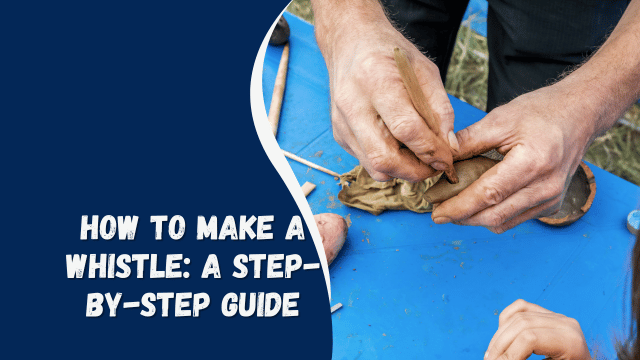How to Make a Whistle: A Step-by-Step Guide

Have you ever been intrigued by the idea of making your own whistle? Whistles are simple yet fascinating instruments that produce sound with just a breath of air. Learning how to craft your own whistle can be a fun and rewarding experience. In this article, we will guide you through the process of making a whistle from common materials found at home or in a craft store. Let’s dive into the world of DIY whistle making!
Gathering Your Materials
Before you embark on your whistle-making adventure, gather the necessary materials. You will need:
- A suitable material for the whistle (wood, plastic, clay, or metal)
- A pencil and ruler for marking
- A saw or craft knife for cutting the material
- Sandpaper for smoothing the edges
- A drill or small file for shaping the mouthpiece and fipple
- Paints and brushes for decoration (optional)
Understanding Whistle Anatomy
To make an effective whistle, it’s essential to understand its three main parts: the mouthpiece, the chamber, and the fipple. The mouthpiece is where you blow air into the whistle, the chamber amplifies the sound, and the fipple is responsible for creating the whistle’s unique sound.
Crafting a Basic Whistle
- Choosing the Right Material: Select a material that suits your preferences and skill level. Beginners may find wood or plastic easier to work with.
- Measuring and Marking: Measure and mark the length of your whistle on the chosen material. Use a ruler and pencil to create accurate markings.
- Carving the Mouthpiece: Carefully shape the mouthpiece at one end of the material. It should be smooth and comfortable to blow into.
- Creating the Chamber: Carve out a hollow section in the middle of the material. This will serve as the resonance chamber.
- Carving the Fipple: At the opposite end of the mouthpiece, create a fipple, which is a narrow, slit-like opening that directs the airflow.
Fine-Tuning Your Whistle
Test your whistle by blowing into it. Make adjustments to the fipple and mouthpiece if needed to achieve the desired pitch and sound quality.
Decorating Your Whistle
Personalize your whistle by adding decorative touches. You can paint it, add designs, or use different materials to create a unique look.
Whistle Care and Maintenance
To keep your whistle in good condition, clean it regularly and store it properly when not in use. Proper maintenance ensures the longevity of your handcrafted whistle.
Safety Precautions
When working with tools, especially if children are involved, prioritize safety. Use appropriate safety gear and supervise young learners.
Exploring Advanced Whistle Making
Once you’ve mastered the basics, you can delve into more advanced whistle making. Explore different types of whistles and experiment with new techniques.
Troubleshooting Your Whistle
Encountering issues with your whistle is normal. Common problems include pitch inconsistencies and air leaks. Learn to troubleshoot and resolve these issues for better results.
Exploring the History of Whistles
Whistles have a long and fascinating history, dating back to ancient times. The earliest known whistles were made from bird bones or clay and were used for communication and signaling. Over the centuries, whistles evolved, and various cultures incorporated them into their traditions.
In ancient civilizations, such as the Aztecs and Mayans, whistles were crafted with intricate designs and used for both ceremonial purposes and in daily life. They were often fashioned in the shapes of animals or deities and played a significant role in religious rituals.
During the Middle Ages, whistles gained popularity among shepherds who used them to communicate over long distances. These early versions were often made from wood or reeds. The simplicity and effectiveness of the whistle as a signaling device made it valuable in both rural and urban settings.
Fast forward to the 19th century, and whistles found a new purpose in maritime navigation. Sailors used them as part of their signaling systems to convey messages between ships and during emergencies. The steam-powered ships of the time relied heavily on whistles to ensure safe navigation.
In the sporting world, whistles became a fixture in referee and coach gear. The distinct sound of a whistle piercing the air became synonymous with the start and end of games, as well as signaling fouls or penalties.
The Science Behind Whistle Sound
The functioning of a whistle is based on the principles of fluid dynamics and acoustics. When air is blown through the fipple, it creates a stream of high-velocity air across the sharp edge of the fipple slot. This generates a turbulent flow and causes the surrounding air to vibrate, producing sound waves.
The pitch of the whistle depends on various factors, including the size and shape of the chamber and the length and width of the fipple slot. By altering these dimensions, one can change the pitch and tone of the whistle.
Whistles in Different Cultures
Whistles are found in various cultural contexts, each with its unique style and purpose. In some Native American tribes, whistles were used during ceremonies and as musical instruments. The haunting melodies of Native American whistles are still cherished in modern times.
In China, traditional ceramic whistles shaped like animals or mythical creatures are considered collectibles and treasured as cultural artifacts.
Whistle Collecting as a Hobby
The art of making whistles has grown into a niche hobby for enthusiasts worldwide. Collectors seek out vintage whistles, handmade pieces, and those with historical significance. Whistle collecting clubs and online forums provide a space for like-minded individuals to share their passion and knowledge.
The Therapeutic Sound of Whistles
Beyond their historical and cultural significance, whistles have also found a place in modern therapeutic practices. Sound therapy, which uses specific tones and frequencies to promote relaxation and healing, sometimes incorporates the use of whistles.
How To Draw Rudolph The Red-Nosed Reindeer
Exploring the History of Whistles
Whistles have a long and fascinating history, dating back to ancient times. The earliest known whistles were made from bird bones or clay and were used for communication and signaling. Over the centuries, whistles evolved, and various cultures incorporated them into their traditions.
In ancient civilizations, such as the Aztecs and Mayans, whistles were crafted with intricate designs and used for both ceremonial purposes and in daily life. They were often fashioned in the shapes of animals or deities and played a significant role in religious rituals.
During the Middle Ages, whistles gained popularity among shepherds who used them to communicate over long distances. These early versions were often made from wood or reeds. The simplicity and effectiveness of the whistle as a signaling device made it valuable in both rural and urban settings.
Fast forward to the 19th century, and whistles found a new purpose in maritime navigation. Sailors used them as part of their signaling systems to convey messages between ships and during emergencies. The steam-powered ships of the time relied heavily on whistles to ensure safe navigation.
In the sporting world, whistles became a fixture in referee and coach gear. The distinct sound of a whistle piercing the air became synonymous with the start and end of games, as well as signaling fouls or penalties.
The Science Behind Whistle Sound
The functioning of a whistle is based on the principles of fluid dynamics and acoustics. When air is blown through the fipple, it creates a stream of high-velocity air across the sharp edge of the fipple slot. This generates a turbulent flow and causes the surrounding air to vibrate, producing sound waves.
The pitch of the whistle depends on various factors, including the size and shape of the chamber and the length and width of the fipple slot. By altering these dimensions, one can change the pitch and tone of the whistle.
Whistles in Different Cultures
Whistles are found in various cultural contexts, each with its unique style and purpose. In some Native American tribes, whistles were used during ceremonies and as musical instruments. The haunting melodies of Native American whistles are still cherished in modern times.
In China, traditional ceramic whistles shaped like animals or mythical creatures are considered collectibles and treasured as cultural artifacts.
Whistle Collecting as a Hobby
The art of making whistles has grown into a niche hobby for enthusiasts worldwide. Collectors seek out vintage whistles, handmade pieces, and those with historical significance. Whistle collecting clubs and online forums provide a space for like-minded individuals to share their passion and knowledge.
The Therapeutic Sound of Whistles
Beyond their historical and cultural significance, whistles have also found a place in modern therapeutic practices. Sound therapy, which uses specific tones and frequencies to promote relaxation and healing, sometimes incorporates the use of whistles.
Conclusion
Making a whistle from scratch is a gratifying experience that connects you to ancient traditions and the world of sound. Whether you’re a craftsman, a collector, or someone looking for a unique hobby, learning how to make a whistle opens up a world of creativity and self-expression. So why not grab your materials and embark on a whistling adventure today?
FAQs
Is whistle making an eco-friendly hobby?
Yes, using sustainable materials like bamboo or recycled plastic for whistle making can contribute to eco-friendliness.
Can I make a whistle that plays melodies?
While basic whistles produce simple tones, with advanced techniques, you can create whistles capable of playing simple melodies.
Are there any famous whistles in history?
The “Bobby Whistle,” used by police officers in London, is one of the most iconic and recognizable whistles globally.
Are there any health benefits associated with whistling?
Whistling is known to improve lung capacity and can serve as a form of stress relief and relaxation.
Can I customize my whistle with engravings?
Absolutely! Personalizing your whistle with engravings adds a special touch and makes it truly your own.


